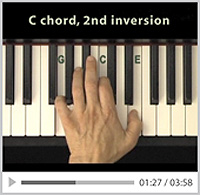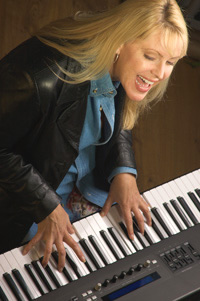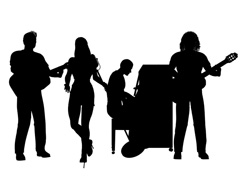Play & Sing Course Guide

If you're a beginner, I recommend that you start at the beginning and work your way through each lesson.
You might want to keep the course list open in one tab in your browser. That way, when you finish a lesson, you can easily access the link to the next one.
If you're one of those people who likes to explore the philosophy behind what you're doing, I recommend The Top 3 Myths About Learning to Play the Piano.
Laying the groundwork
The first several lessons of Play & Sing teach ground-level music theory, including note names and locations, intervals, and chord basics. These very quick lessons zero in on what you'll actually need at this point and no more, so you can get right to the lessons in which you begin to play.
In Playing Your First Piece, You'll master the basics of piano technique while learning to play a simple chord-based piece.

The lesson on chord inversions is especially important. I've known students who could play any chord in any key, but because they didn't know how to use inversions to create smooth transitions between chords, weren't able to put their knowledge to use. The Chord Inversion Exercise, together with the lessons that follow, solves this problem.
Song Essentials prepares you for playing your first accompaniment by introducing a few basic concepts: chord progressions, chord charts, and piano/vocal arrangements.
Beginning to accompany
The four lessons that begin with How to Play a Simple Ballad teach you to accompany yourself on a 3-chord song. They cover fingering, how to read a chord chart, how to play a bass line, coordinating your singing and playing, and more. These tutorials not only give you the information you need, but show you how to practice.

How to Play a Simple Ballad is especially important. It teaches you to move from one chord position, or inversion, to the next. This is one of the key challenges in learning to play. When you can handle it easily, you'll be all set to enjoy the rest of the course.
Learning to pedal; more theory
When you can play a basic arrangement like the one in How to Play a Simple Ballad with ease--but not before--you're ready for the tutorial called How to Use the Sustain Pedal.
You'll be thrilled at how beautiful your playing will begin to sound when you learn to use the pedal effectively, and this tutorial makes it easy.
The next three lessons, on theory again, add to your growing understanding of how music works, and prepare you for what's to come. They cover whole steps and half steps, major scale structure (so you can build any chord), and how to transpose using a number system.Building a repertoire of songs and styles
The Piano Accompaniment Styles for 50 Great Songs tutorials move at a quicker pace. They take the chords and skills you've learned so far and apply them to a huge assortment of songs, by using rhythm styles or patterns. If chord inversions make chord changes smooth and easy, rhythm styles make them exciting.

How to Play a 12-Bar Blues Shuffle teaches in greater depth a style that's briefly touched on in the previous lesson. You can use this bouncy piano style to accompany songs like Hound Dog, Kansas City, Whole Lotta Shakin’ and many more.
The tutorial on John Lennon's Imagine adds a richer and slightly more difficult pattern to your growing repertoire of accompaniment styles. In this one, the left hand plays two notes instead of one.
Piano Styles for No One, Someone Like You, She Will be Loved, and Other 1-5-6-4 Songs is the first lesson in Pop Piano Accompaniment, the course that picks up where Play & Sing leaves off. Includes songs by Adele, Alicia Keys, Maroon 5, U2, Elton John, The Beatles, The Police, RHCP, and others.
Videos that are not part of Play & Sing.
Basic Piano Technique: A Whole-Body Approach (Parts 1 & 2) introduces the physical aspects of playing. This lesson is perfect for beginners, but also for more advanced students who may have missed some basics along the way. I strongly recommend it!
The Ode to Joy tutorials are different from the other videos. They teach you to play a piano solo rather than an accompaniment. Since they're on a different "track" than other lessons and don't require much chord expertise, feel free to try them after you've mastered the lessons on basic technique.
How to Play Big Leaps with Ease may appeal to more advanced players, though its mantra--"hurry up and wait"--is right on target for pianists at every level.
How to get the most out of the course.
The videos break down complex skills for you, demonstrating each baby step you need to take. (This is less true of the Piano Accompaniment Styles lessons, which cover a lot of ground and move fast.) You'll know exactly what to practice and how to do it. But what's up to you is truly making these skills your own. If you try a particular step once and succeed, that's great—but it's only a start. Keep repeating each practice step until you can play it easily, consistently, and well.
Practice made simple.
If you find yourself making mistakes or playing with tension, slow down. Much of the time, you'll need to practice very slowly indeed. Think slow motion.

As I show you in the tutorials, you can also practice each hand by itself, or focus on just one or two beats at a time. And you'll probably want to save the singing for later so you can concentrate entirely on learning the piano part.
For more on how to practice, see this.
Piano or keyboard?
Students often ask me what kind of instrument I recommend for practicing. You'll find some thoughts on that here on the site devoted to my private teaching.
The DoctorKeys philosophy.
At some point, I recommend that you read my article The Top 3 Myths About Learning to Play the Piano. It discusses:
• Reading vs playing by ear.
• Why piano technique is not just about how you use your fingers.
• The difference between playing and practicing.
It's loaded with tips, exercises, and resources that will help you get the most out of the course.
Go to it!
And now, I invite you to dig in and start learning.
If you haven't yet followed the links to it, my article called The Top Three Myths About Learning to Play the Piano explains the basic principles on which these lessons are based. It also has exercises, links to other resources, and practice strategies.
Enjoy!
---Bruce